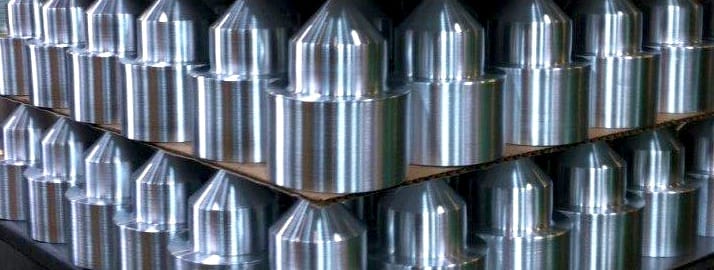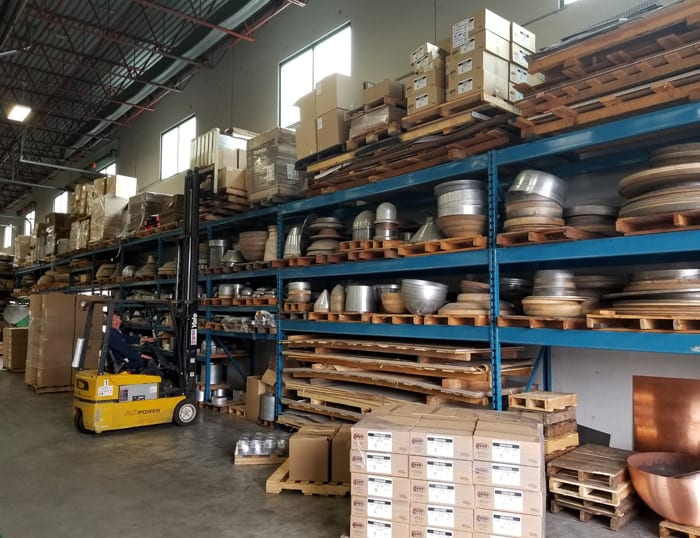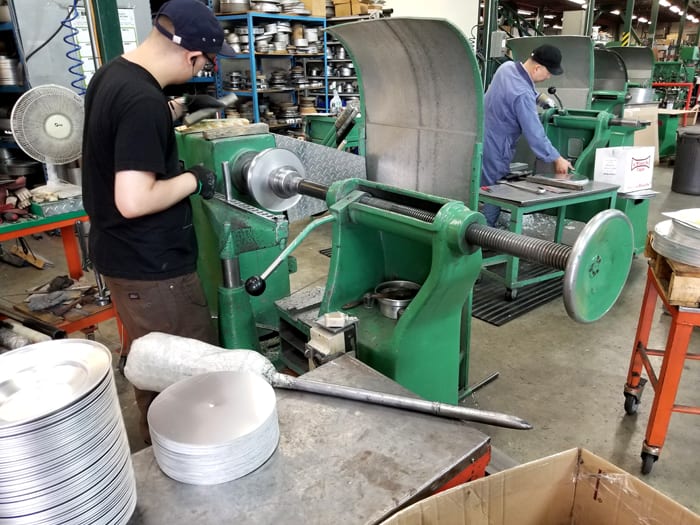We missed last week's Cool Links, so we'll empty our backlog and throw a few extras your way. 1-Bit Symphony This whole album is chiptunes all done on a microcontroller and placed in a CD case. The album/cover art is actually what makes the music. Ted Talk - Massimo Banzi: How Arduino is open-sourcing imagination […]

Metal Spinning Field Trip
We've been researching a manufacturer for a shiny new product we are working on (shhh, don't tell anyone and stay tuned for the reveal!). What we have been looking for is a metal spinner. Metal spinning, also known as spin forming, spinning, or metal turning most commonly, is a metalworking process by which a disc of metal is rotated at high speed and formed into an axially symmetric part. Spinning can be performed by hand or by CNC lathe.
 After doing lots and lots (and some more!) of internet browsing we came across Sieg’s Manufacturing (pronounced /seɪdʒ/). It is a family-operated shop that has been in business for more than 40 years and is located in Langley, British Columbia. It is one of only a few companies on the west coast who spin metal, serving most of Western Canada and the north western quadrant of USA. Being the closest manufacturer to us other than a random Hutterite colony in the middle of nowhere, it was worth a flight to Vancouver to check them out. So our emissary hopped on a plane for a day trip and brought back some stories.
After doing lots and lots (and some more!) of internet browsing we came across Sieg’s Manufacturing (pronounced /seɪdʒ/). It is a family-operated shop that has been in business for more than 40 years and is located in Langley, British Columbia. It is one of only a few companies on the west coast who spin metal, serving most of Western Canada and the north western quadrant of USA. Being the closest manufacturer to us other than a random Hutterite colony in the middle of nowhere, it was worth a flight to Vancouver to check them out. So our emissary hopped on a plane for a day trip and brought back some stories.
Sieg's Manufacturing is a pretty slick operation that pumps through a TON of different metal spun products. In the picture below we can see a portion of tools these wizards use to form and contour the metal disc into the desired shape. Tools can be machined out of wood or steel and are used to act as the "die" that the metal is spun around to form the final product. While a wood tool is cheaper to machine, a steel tool is the standard for large volume production runs where you need to produce more than 600-700 units. The more you use the tool, the more its sharp edges and ridged shape begin to dull.
 The process of metal spinning is actually quite interesting. Sheet metal of the preferred gauge is cut down to manageable squares and again into circular blanks to be used on the lathe. The blank is then brought over to the hydraulic punch to create the necessary holes required by the design, such as mounting holes, viewports, or drainage holes. Depending on the quantity to be produced, the punched blank is mounted to a CNC or hand operated lathe and the user/machine bends the metal around the tool until the blank has reached the desired shape.
The process of metal spinning is actually quite interesting. Sheet metal of the preferred gauge is cut down to manageable squares and again into circular blanks to be used on the lathe. The blank is then brought over to the hydraulic punch to create the necessary holes required by the design, such as mounting holes, viewports, or drainage holes. Depending on the quantity to be produced, the punched blank is mounted to a CNC or hand operated lathe and the user/machine bends the metal around the tool until the blank has reached the desired shape.
 The finished product can be removed from the machine with a default surface finish or can be cleaned up with a sexy brushed surface finish which gives it a nice textured look. The above image shows a stack of finished parts used for smoke stack covers on the left, and the unmolded blanks sitting directly to the right of them.
The finished product can be removed from the machine with a default surface finish or can be cleaned up with a sexy brushed surface finish which gives it a nice textured look. The above image shows a stack of finished parts used for smoke stack covers on the left, and the unmolded blanks sitting directly to the right of them.
All in all, our little field trip was a success, giving us more insight into how parts of our super secret product will be manufactured for your eventual enjoyment!
MORE POSTS
Transparent Aluminum Well, technically not exactly aluminum, but aluminum-based ceramic called aluminum oxynitride. Still with quite magical properties. (Via Makezine) Concealed Layers of Product Life Renee Verhoeven's grad project explores the relationship between anatomy and mobility in the series of gloves, using laser cutting. (Via Mocoloco) Asian Snack Enamel Pins These lovely pins by giantrobot.com […]
Well, we're already half-way through December and the days, snow, and cold temperatures keep rolling on. For those of you in need to get some last-minute shopping in before the holidays hit, you're in luck. For the next two weeks (until Dec 29th) we have two totally-awesome Arduino-type deals: Shieldpack (This promotion has ended. Better […]
I can't imagine why, but some people want to use these push pogo pins for other uses than robot appendages. Or battery contacts. Apparently they're really good for something called "JTAG applications" too, but I'll leave that up to you to decide. Scroll down to see them listed in the "New Items" column.
Solarbotics, Ltd. is not responsible for misprints or errors on product prices or information. For more information, please see our Terms and Conditions.
Warning: This product contains chemicals known to the State of California to cause cancer and birth defects or other reproductive harm.
Please visit www.P65Warnings.ca.gov for more information. This item was manufactured prior to August 31, 2018.


